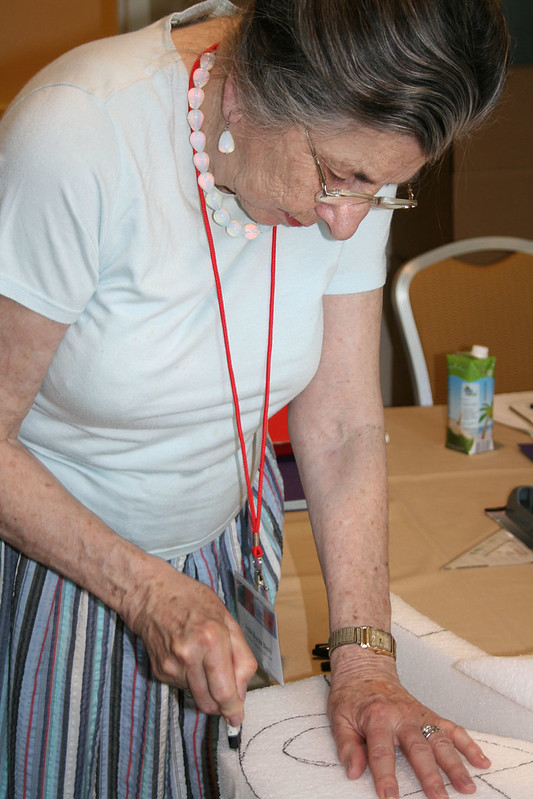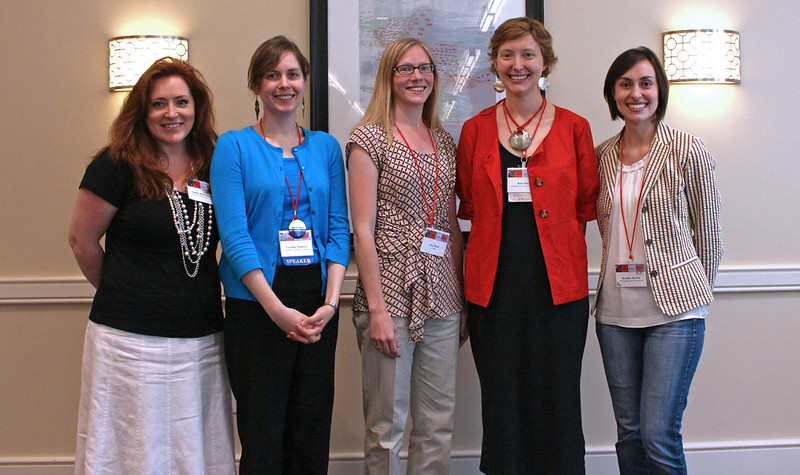This panel featured 4 textile conservators, 2 in private practice (Julia Brennan and Mary Wasserman) and 2 working for large museums (Susan Heald and Christine Giuntini). All have written a chapter in the forthcoming book by Patricia Ewer and Frances Lennard, on the topic of textile conservation.
Julia Brennan started off, with a description of how she conducts herself on her many overseas conservation projects, many times working in less-developed countries. She made the point that ethics to her means having a sensitivity and understanding of another set of values. It requires having respect for, and developing trust with other parties, in order to create a partnership, which leads to progress and thus accomplishment of the objective. For her, it is helpful to remember that each artifact is more than that – it can also be a living relic. She referred back to something that was said during the workshop on Tuesday, regarding Best Practices for CAP surveys: “Don’t let ‘perfect’ get in the way of ‘good’, and finds that this helps her when she finds herself often working with less-than-ideal circumstances. She also mentioned that she is often bound by unwritten agreements of confidentiality, which, if she were to break them, would be a severe ethical infraction. It was a nice discussion, where the sensitive nature of her work was apparent.
Next, Christine Giuntini spoke mostly about her experiences at the Metropolitan Museum of Art, wherer she works with curators and designers almost exclusively. Their collaboration guides her decision-making, and affects why she does what she does. She also illustrated her comments using several slides from work from the early 1980s. Exhibits of ethnographic pieces were presented then as pieces of fine art, a different approach than is usually taken today. As she said, “you do the best you can, based on the information that you have”, and that we use information to change and inform the decisions we make as conservators. Context is key, and this idea kept coming up over and over again, with each of the 4 speakers. Christine asked us all to remember – especially the yonger conservators – that there was a time, pre-Ethafoam, when we were all using blue-board on wooden frames to make supports, and this was common practice. Our decisions and practices were shaped by the availability of materials, some of which were not even invented then!
Susan Heald spoke next, and she referred to both the tangible and intangible aspects of Cultural Heritage. She specifically referenced the UNESCO convention of 2003, which specifically talks about the need to safeguard both tangible and intangible aspects of culture. At NMAI, where she works, they see themselves as the custodians of heritage, not the owner. She also compared the CCI 1986 Conference on the Care and Preservation of Ethnographic materials, where very few native people were in attendance, with the 2007 Symposium on the same topic, which featured a much larger number of presenters being native people. She closed by referencing the AIC Code of Ethics from 1994, which talks about the necesity of having an informed respect for property, and also the 2004 ICOM Code of Ethics, which states the need to take into account the interests and beliefs of the community – the source of the heritage. It was a good reminder that we really do have a concrete basis for the belief system that we all should hold, if we consider ourselves to be professional conservators. Some pretty serious people have given these concepts serious thought, and have produced documents upon which we base our actions as professionals.
Finally, Mary Wasserman spoke of her experience in Florence, Italy, where she has been practicing textile conservation for a very long time (that’s what she said!) The case study that she wrote about for the new book took place in a historic house over a period of 10 years. It included the need to replace a collection of silk banners which had been hung from the ceiling, but which were returned to their place of origin, thus necessitating the creation of reproductions. Photographic reproductions were made and printed on new silk fabric, which were then fabricated into banners and re-hung on the ceiling, where the originals had been originally. Mary stressed that this was a collaborative effort between 2 teams of conservators, and this collaboration guided the decision-making throughout this very long project. Being well informed of the topic before even starting the work was key to her work, which echoed what Christine had just said: you do the best job that you can, with the information that you have.
In the ensuing general discussion from the floor, various comments were made – it’s difficult to repeat them all, but here are some snippets: Context trumps all in decision-making….. it all comes down to the availability of materials…..sometimes you find yourself deviating from your training, depending on the audience you are working with and their level of sophistication and differing values….. it’s not YOUR collection, it’s THEIR collection……There is no right or wrong, it’s what’s best in the context of the present ?…. this attitude extends to working with very small museums, without any paid staff (this echoes what was said during the CAP workshop: the worst thing you can do is to come into an all volunteer situation, and tell them everything they have been doing is wrong!!!)…the success of our outreach depends on a change in attitude, and the development of respect for local context and resources….. question: is it ethical for an institution to hold collections when they don’t have the staff to care for them?…..conservators have to be flexible, in order to work with all kinds of situations, and to develop achievable goals wherever they find themselves (another echo from the CAP workshop!) Final question: is it ever ethical to leave out the words when writing a condition report – and just rely on photographs?
This panel discussion was time well spent, and everyone was sorry to hear that time was UP!!!






